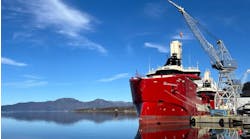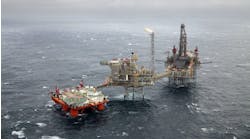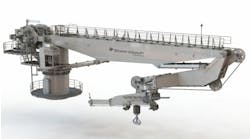High uptime despite lack of swivel, dynamic positioning
Illustration of tripod catenary loading system.The development of the tripod catenary mooring and loading system, also known as TCMS, arose out of Victoria Oilfield Development's desire to enhance the early production system (EPS) and the ability to perform extended well tests (EWT).
One way to achieve this was by looking at the tanker issues normally attached to these projects. The aim was to develop a mooring and loading system that could take advantage of conventional tankers - the single fixed pitch propeller tanker - rather than expensive dynamically positioned (DP) tankers that are often difficult to obtain due to restricted availability.
The concept is similar to the pipeline support system deployed on the Foinaven EWT in 5l0 meters of water, which incorporated a tripod arrangement l00 meters below the sea surface which served as the riser base for the tanker.
The challenge was to modify the tripod to use traditional mooring com po nents in order to achieve l00% weather vaning capability without contact between the moor ing legs and the vessel keel, in an effort to create a safe loading path for oil. The current system layout is the result of the develop ment work that was under taken in l995, which in volved a two day exercise in deploying and weather vaning such a system.
The design of any individual mooring or riser system has a set of criteria and load cases to be examined and con formed to, with the integration of a mooring and riser system expanding the complexities of the design. The software package, Orcaflex, played a role in designing the TCMS, allowing the required complex modeling to be carried out and removing some of the "black art" associated with mooring design.
For example, the software package made it possible to quantify the dynamic loads which result from having one chain heaving on three mooring lines simultaneously, and to fully analyze the system in its disconnected state.
In two l996 system applications, uptime on the Pierce and Hermod Fields was l00%. Despite harsh weather conditions), no disconnection was necessary. The load limit of the chafe chain was not transgressed.
There is now a generic layout of the chafe chain length, mooring leg top buoyancies and pretension, and the optimum type of hose to use has been identified. The latter has been chosen as a bonded construction which offers advantages which lie in its ability to accept torsion and is particularly user-friendly. It also features additional benefits in thermal conductivity and ease of deployment. The hose's low elasticity at operational loadings also reduces the reliance on the catenary profile in accommodating large node offsets.
The weathervaning of the tanker is made possible by the natural tendency of bonded hose to helix - or corkscrew - as twist is applied to it. This eliminates the need for a swivel and thus reduces maintenance requirements and increases reliability. Typically, the maximum allowable rotation for a tanker on the TCMS is three turns in either direction, or a total of six turns. For an export system where loading may typically last only 24-36 hours, this is unlikely to be exceeded. For longer term loadings, modeling and full scale tests have shown how simple and safe it is for the tankers to turn themselves around the chafe chain.
The facility is being used currently on Texaco's Mariner Field in the North Sea. A 600,000 bbl capacity tanker, the MV Hellespont Prosperity, which has been used to carry out an EWT and EPS has been loading via a TCMS. The MV Hellespont Prosperity has been on station since mid-May, achieving 100% uptime. The tanker is operated and managed by Seatramp, a member of the Hellespont Group, as is Victoria Oilfield Development.
The TCMS can be adjusted to work in a wide variety of scenarios, including shallow water. This is made possible by having the chafe chain connection at the forecastle fairlead at the highest point forward above the waterline, thereby reducing problems associated with high mooring stiffness at shallow depths.
The system may also be used in deep water, the limitation being the same as other systems when mooring in large depths: the deeper the water, the closer the global response of the system then becomes to a simple three point mooring, thus simplify ing the analysis. In deepwater, over 400 meters for example, the use of a TCMS with a node about 20 meters below the surface allows for the use of a suspended pipeline system direct from the processing or storage facility, thus allowing major riser system cost savings.
Although the system has been used on a number of EWTs, achieving l00% uptime in eight-meter significant seas, the system also lends itself to full shuttle tanker capability on a longer term basis. This is possible because the modifications to a vessel are minor, and essentially limited to having a 300-ton mooring connection forward, while most tankers are already equipped with a least 200 tons.
By using two export systems on a field, even greater benefits are experienced. Unlike competing single export systems which require a tanker to standby, the twin system export system allows one tanker to connect while a second tanker disconnects from a separate mooring. It can, therefore, actually speed up the discharge process as well as providing l00% redundancy.
This redundancy eliminates any need for field shutdowns during inspection and maintenance. Except in the most extreme weather, the FPSO or production facility will never have to standby waiting for a tanker which drives down operator costs and increases project returns. There are also safety benefits in that marine risks are minimized by providing considerable searoom between vessels.
The benefit has resulted in an important long-term export system contract for Victoria Oilfield Development from a major oil operator in the North Sea. Two tankers will be dedicated to this project, shuttling crude from the TCMS to European ports. The project is scheduled to commence in the summer of 1998 with an expected field life in excess of five years.
Copyright 1997 Oil & Gas Journal. All Rights Reserved.


